HAVING A CONVERSATION WITH VACHARANONT SINVARAVATN WHOSE LANDSCAPE PAINTINGS ARE A FAR CRY FROM THE IDEAS AND CONCEPTS OF ‘ROMANTIC’ BUT INSTEAD QUESTION THE ‘ROMANTICIZATION’ OF THE COUNTRYSIDE
TEXT: TUNYAPORN HONGTONG
PHOTO: KETSIREE WONGWAN EXCEPT AS NOTED
(For Thai, press here)
The fifteen paintings that Vacharanont Sinvaravat featured in his recently concluded exhibition in June ‘The Boundary of Solitude’ at SAC Gallery portrayed the hauntingly beautiful yet tranquil landscapes of Thailand’s countryside.
There is nothing wrong with the above sentence, but it may characterize Vacharanont’s art as romantic, which is a far cry from the ideas and concepts that underpin his paintings. If we used the word ‘romanticize’ instead of ‘romantic,’ we could get a little closer to pinpointing his artistic realm.
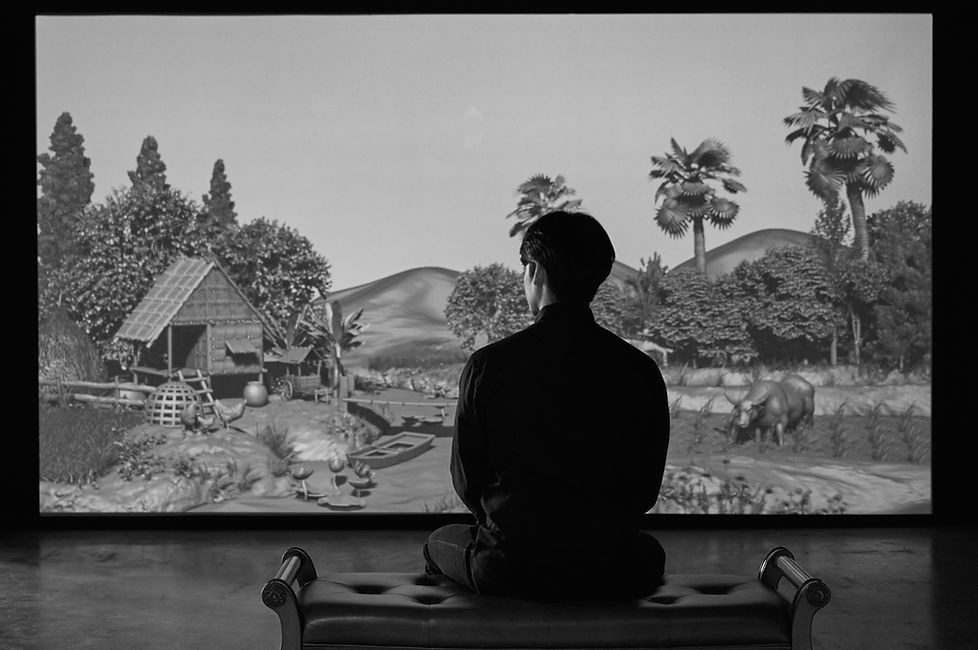
Photo: Preecha Pattara
“I’m interested in the depiction of rural imagery, not in the literal sense, but in the way ‘images’ interact with us humans. Why do people who grew up in a city or live in a shophouse in a commercial area in provinces outside of Bangkok or other big cities, who have never had the experience of running around in a rice field, almost automatically draw this same image of the countryside? We believe, with a certainty that there must be a shed, a mountain range, birds in a shape that looks like the letter ‘m’, and the sun. And why do so many people who appear to have no connection to the countryside wish to own a home there?”
“That’s where it all started,” Vacharanont says about the origins of his landscape paintings. “Landscape paintings depict the world beyond one’s existence while also allowing us to see the landscape of our own mind and what it is made of.”

The Boundary of Solitude
Vacharanont’s landscape paintings are not entirely realistic, but they do share some elements with the aesthetics of contemporary illustration. Perhaps it has something to do with his background and training in mixed media from Silpakorn University’s Faculty of Painting, Sculpture, and Printmaking, which has influenced him to see landscapes through the lens of a photographer. He was probably, to a certain extent, freed from the constraints of traditional compositions, colors, and perspectives because he wasn’t classically trained as a painter like those who majored in painting.
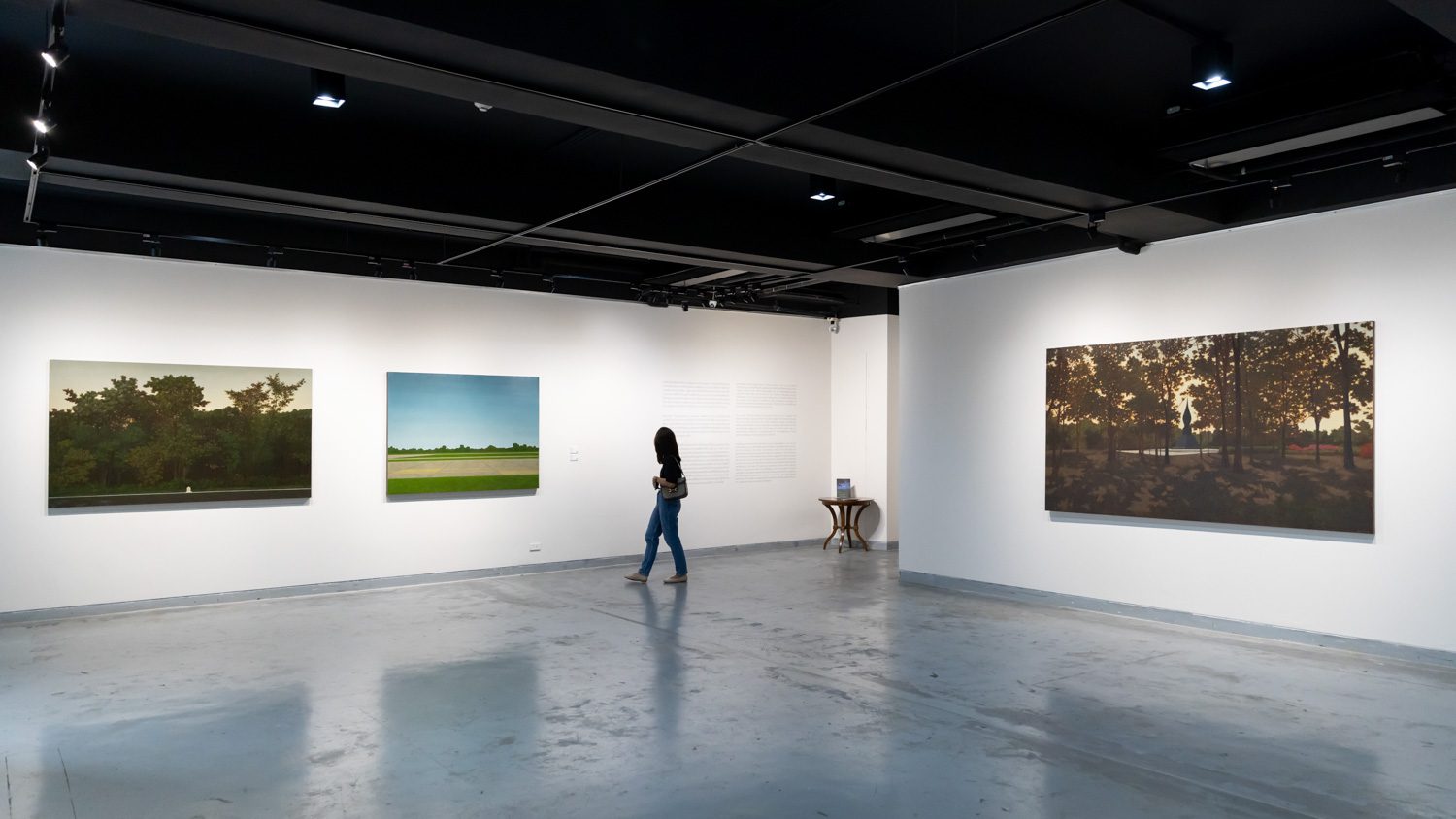
The Boundary of Solitude

The Boundary of Solitude

The Boundary of Solitude
“The first of two rooms in The Boundary of Solitude’ displayed the paintings I did in the early stage of the project when I was still quite cautious with the intense subject matters I was working with. That resulted in the paintings being rather realistic. But after a while of working and revisiting the same subject several times, I began to feel more comfortable about it. As a result, the painting in the second room is more about the presentation of mood and tone than meaning.”
“Let me give you an example of the painting in the second room. There were two paintings: one of a mountain with a red sky and one of a mountain with a blue sky. There are some artificial curves in the two mountains, which stem from my experience encountering these two mountains when I was riding in a car. I was traveling on this road that cut across the Phu Phan mountain range while I was doing a survey, and through this area, there were countless small to medium-sized mountains everywhere. I drove for around two hours before I was able to leave the region. I noticed how the curves of these mountains changed as the car traveled forward. The overall mood and moment stayed with me more than the sight I saw from observation decks overlooking the mountainous terrain. These two paintings were created without referencing any photographs. I’ve never really trusted the objectivity of photographs anyway because even different brands of smartphones can record an angle differently, and the curve of each person’s camera and eye lens varies. As a result, I painted the two paintings based on the atmosphere I could recall from that event.”

The Boundary of Solitude | Photo: Marisa Srijunpleang
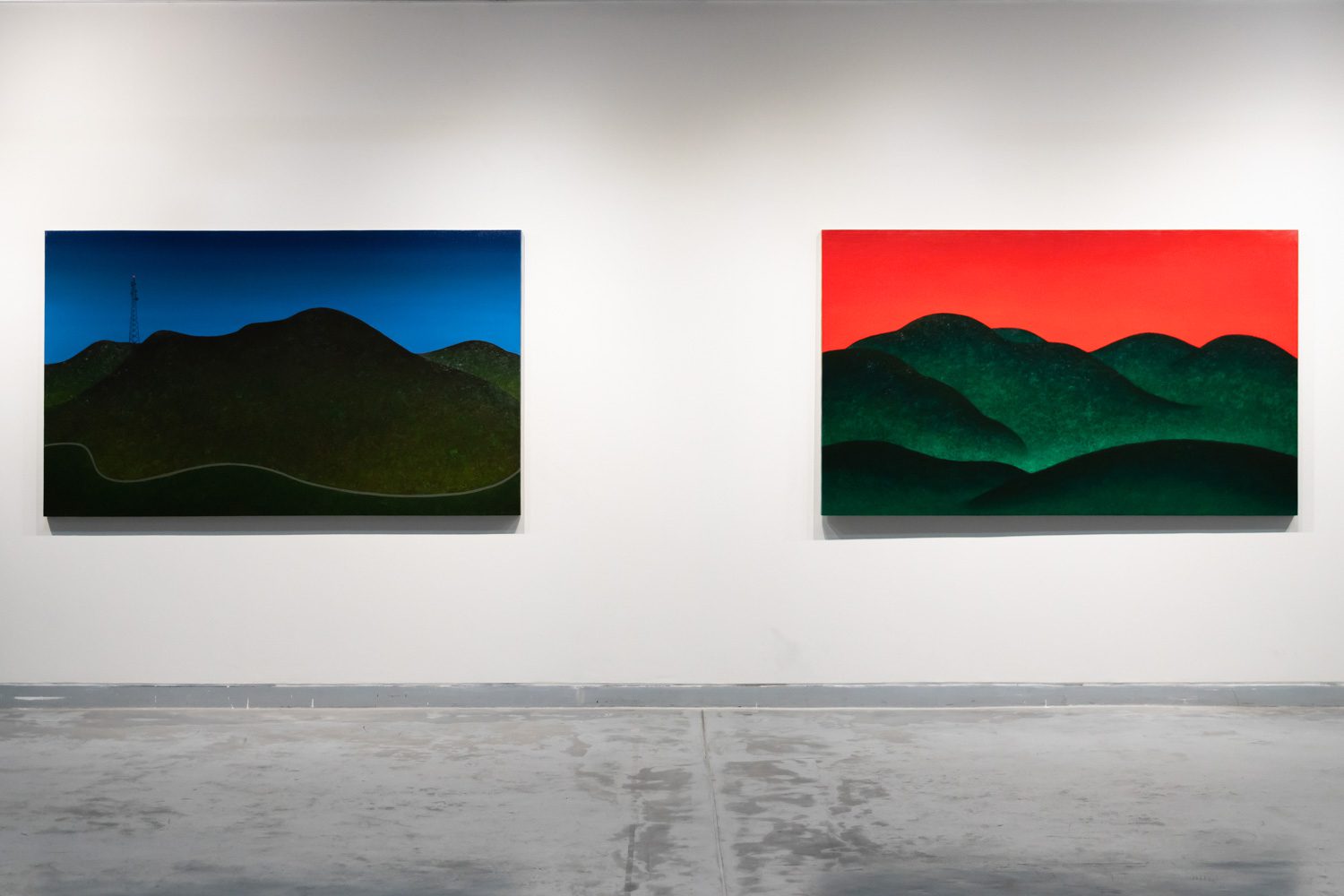
The Boundary of Solitude
The sensitive subject he alluded to before is the history of the Phu Phan mountain range. Previously, this extremely ‘red’ zone was a constant battleground between the Thai state and the communists. Vacharanont chose this specific area as the subject of his landscape paintings because, while researching how the rural imagery impacts him artistically and personally, he did research that led him to revisit past incidents. Later, he discovered that Thailand’s countryside underwent significant changes after the implementation of the First National Economic and Social Development Plan. This plan went into effect during the Cold War era, when the Thai Government received support from the United States to construct and develop the country’s infrastructure and public utility systems. Vacharanont discovered through his research how the Tom Yam Goong Crisis sparked a rise in discussions pertaining to the philosophy of sufficient economy, frequently with a particular depiction of the Thai countryside.

The Boundary of Solitude
Landscape paintings, red zones, the Cold War, and a search for an answer to how the countryside has been used to impact people are the subjects that can be found in many of Vacharanont’s works. ‘Countryside before Memories’ was one of the works featured in the group exhibition ‘Future Tense’, held two years prior at the Jim Thompson Art Center. Not only did Vacharanont include a painting that bore many similarities to the works he later created for ‘The Boundary of Solitude,’ but he additionally produced a 19-minute-long video piece that told the story of Thailand during the Cold War when the First National Economic and Social Development Plan came into effect, as well as the story of the emerging popularity of a sufficient economy following the Tom Yam Goong economic crisis.
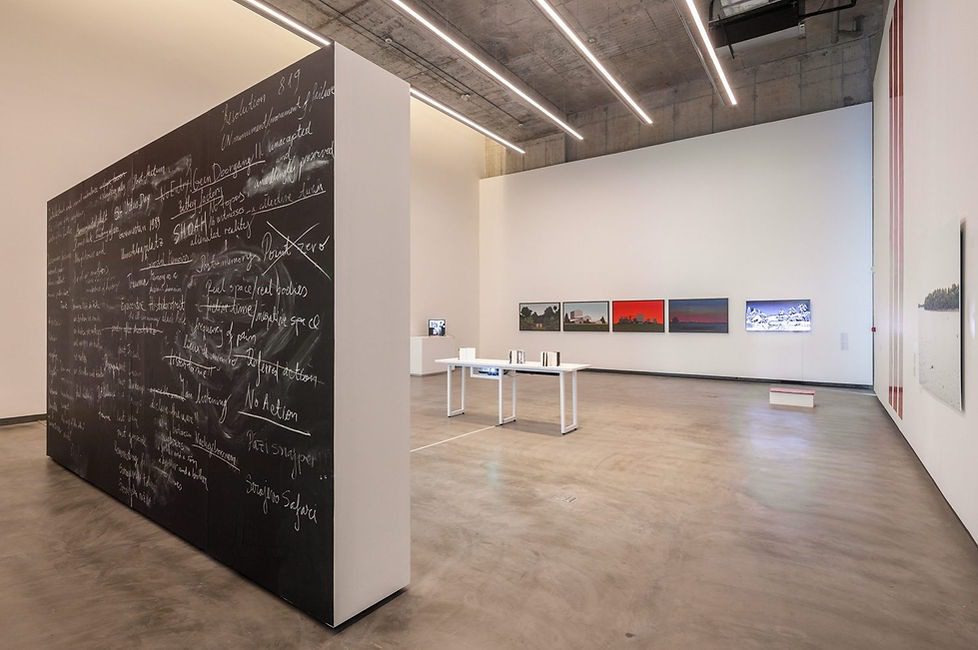
Countryside before Memories
“My original fascination was not with the Cold War. I was interested in what was going on in the present. But, as I mentioned earlier, it all began with the countryside landscape. When I was doing research for ‘Countryside before Memories,’ I realized that this rural imagery has always been utilized as political propaganda in a very sophisticated and subtle way. Because there were no clues as to which ideology this specific image of the countryside served. The fact that it was so discreet makes it all the more intriguing to investigate what it has been and is doing to us.”
Skepticism is unquestionably a component of Vacharanont’s personality. That, combined with the fact that he was born in the same year as the Tom Yam Goong crisis (1997) and that he was a high school student during the peak of the Democratic Reform Committee Movement (PDRC) demonstration, which led to the 2014 coup d’état, The timeline implies that the Junta government took over the nation throughout the entire four years he was a university student. Simply speaking, the rebellious phase in his life in which he spent searching for all kinds of answers coincided with a moment in Thailand’s political landscape that had become warped out of shape. Being exposed to an enormous amount of information with completely polarizing views has most likely heightened his doubts about many aspects of society.
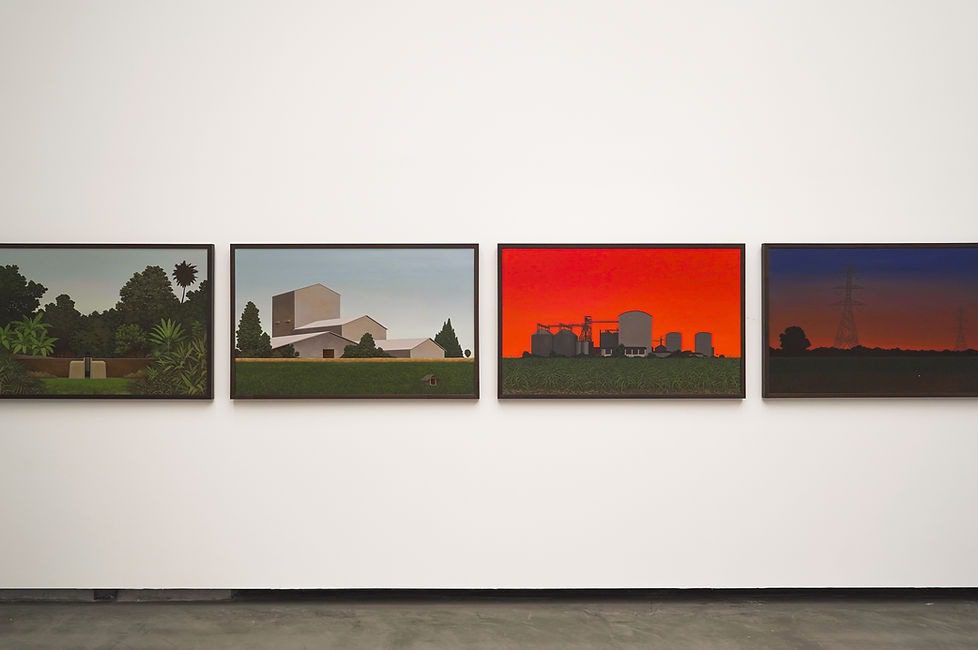
Countryside before Memories | Photo courtesy of Vacharanont Sinvaravatn
“I’ve been interested in politics since I was in middle school. I didn’t know much at the time. I recall watching this show, Question Time, that featured Professor Sulak Sivaraksa and Professor Somsak Jeamteerasakul when I was in my first or second year of high school. I believe that was the point at which I began to pay attention; politics was already in a tailspin, and no one could anticipate what would happen. I used to favor Professor Sulak Sivaraksa, but not so much anymore.”
“My interest in politics and the questions I had about landscape paintings undoubtedly developed in tandem until they eventually collided when I began working on ‘Countryside before Memories.’ I thought my job would be obsolete by now,” he joked. ” I thought stories about the Cold War and Communism must have lost some of their punch. But they remain, like ghosts—the ones in Thai films who are unaware that they have died. Just a few days ago, there were speculations about a US Army facility being established in Thailand, as well as the commotion surrounding the hammer and sickle in the Move Forward Party’s campaign animation. I would never have imagined that people still take this nonsense seriously.”

The Boundary of Solitude | Photo: Marisa Srijunpleang
“Another parallel I see between the Cold War era and current politics is the shift in Thailand’s relationship with powerful nations. During the Sarit Thanarat and Thanom Kittikachorn regimes, which coincided with the Cold War, the Thai state was supported by the US, whereas anti-government students were supported by China. It’s now entirely the contrary. The Thai administration, established by the National Council for Peace and Order (NCPO), forged a close relationship with China, while foreign assistance in the form of formal letters and announcements to anti-government protestors was often from Western countries.”
The research he did as a part of his art-making process included reading books by many revered and respected academics and authors, including Kengkij Kitirianglarp, Thongchai Winichakul, Nattapoll Chaiching, Benedict Anderson, Prajak Kongkirati, Paungthong Pawakapan, Eiji Murashima, Pasuk Phongpaichi, and Thikan Srinara, to name a few. Contemporary literature that piques his interest includes works with sociopolitical themes by Wat Wanlayangkoon, Phu Kradat, Dan-aran Saengthong, Veeraporn Nitiprapha, Uthis Haemamool, and certain works by Seksan Prasertkul.
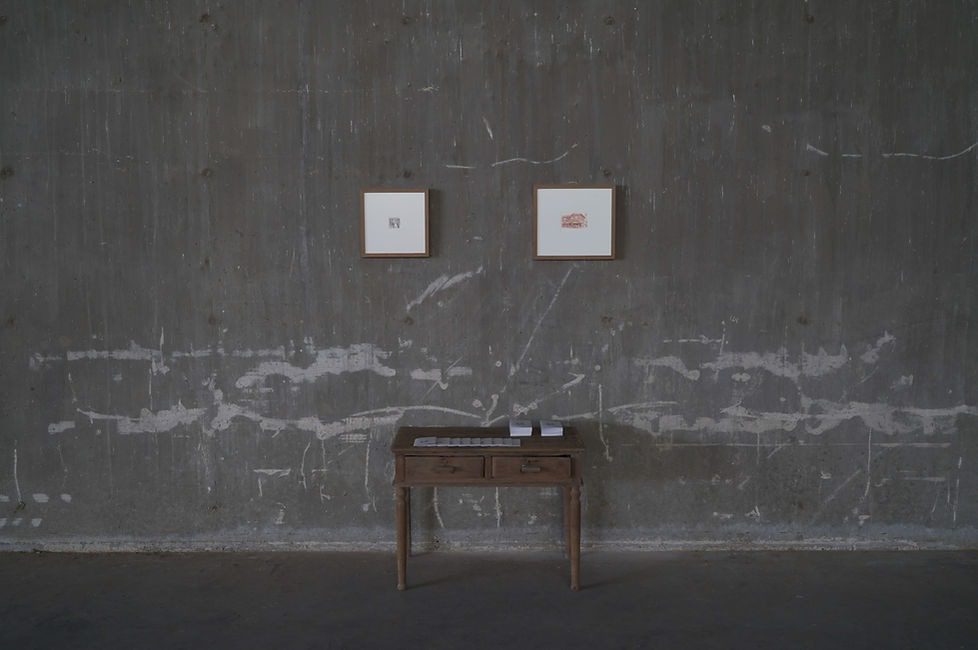
Let the Lion Tell a Short Story | Photo courtesy of Vacharanont Sinvaravatn
Vacharanont never stated that he enjoys writing, but he said that it is a practice he is working on alongside his artistic skills. Nonetheless, in his most recent work for another group exhibition, ‘SUPHAN’S Echoes,’ at 1984+1 Gallery in Suphanburi, his hometown, we will be introduced to his first written work, ‘Let the Lion Tell a Short Story.’ The publication will be presented next to his drawing, where he rewrites stories that were told repeatedly by his family members, some of which remain the same while others do not, into short stories. The stories will be collected and published in a book, which will be distributed to the exhibition’s attendees.
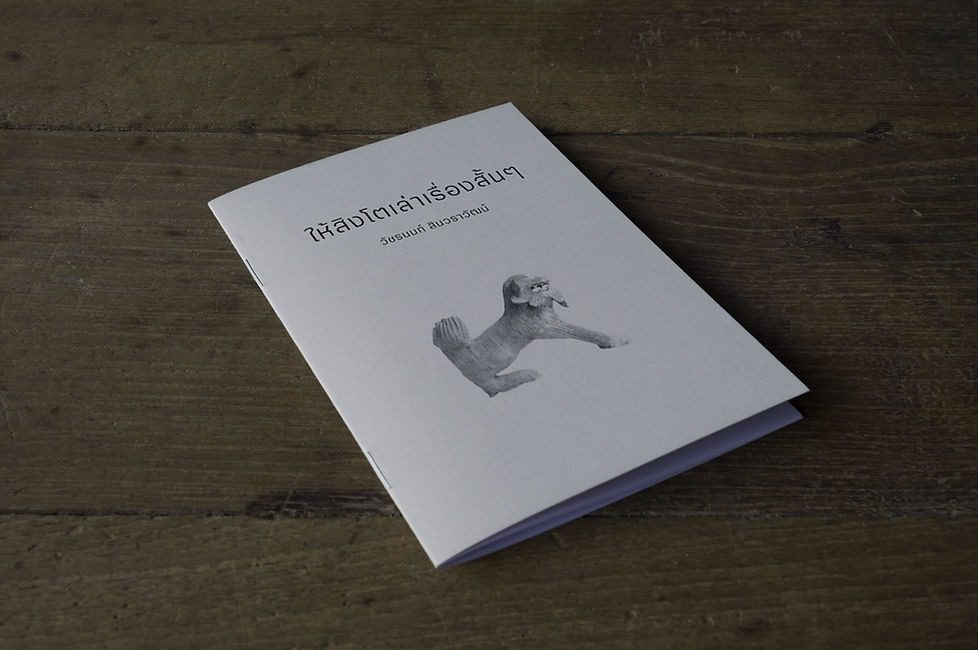
Let the Lion Tell a Short Story | Photo courtesy of Vacharanont Sinvaravatn
“Because the exhibition will be held in Suphanburi, and I am from Suphanburi, I thought I would go back to my own home, taking a more personal route. I discovered a Chinese lion sculpture built by my great-grandfather to fix improper feng shui. I think his skills and liking for art and craft somehow found their way to me. Anyway, I was planning to feature the lion in my work, but my family wouldn’t let me because the lion serves as a guardian for our home, which is located across the street from a hospital. So I use that as the foundation of my short stories, which are based on my endeavor to collect all of the stories that have been talked about in our family but have never been properly put together before, while drawing parallels between these stories and the changing landscape of my hometown.”

Concerning the 2-3 landscape series he has been working on, Vacharanont said that he has a plan for projects that he will do, but he cannot share much about them for the time being.

